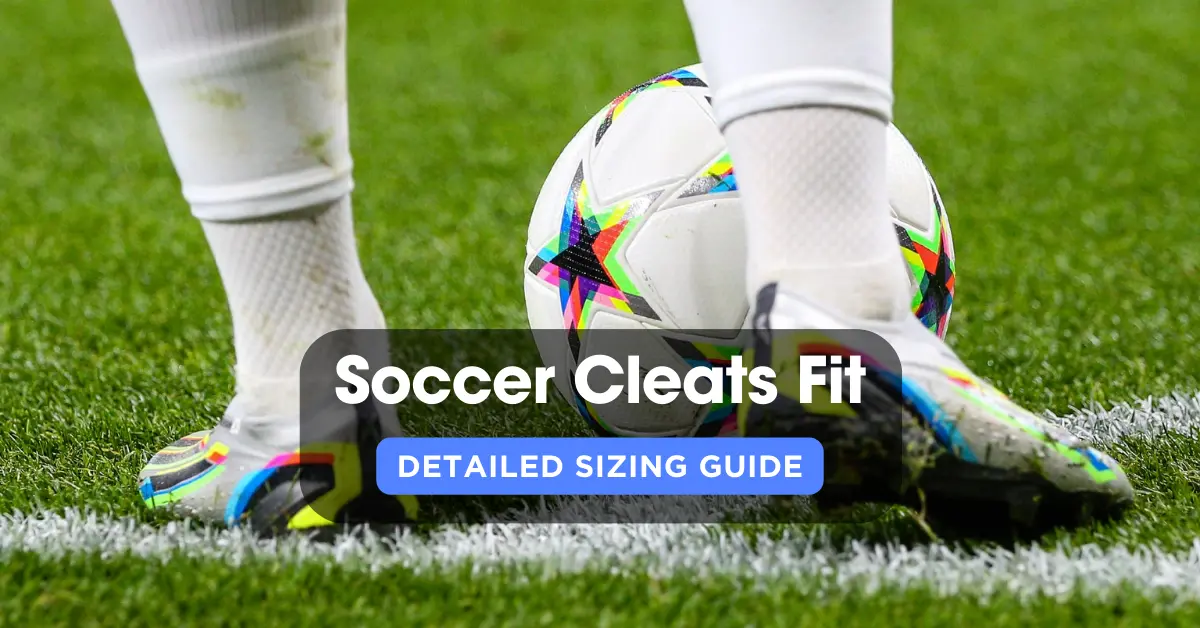How Should Soccer Cleats Fit? Detailed Sizing Guide In 2024
Soccer cleats are one of the most important pieces of equipment for any player. They provide traction and stability on the field and can make all the difference in a player’s performance. But how should soccer cleats fit?
Your soccer cleat should ensure a snug fit on your feet. It should feel like socks when you wear them. But many pro athletes often choose to stick to a lower size because they want to ensure more control over their touch.
Different great soccer players prefer different fits for their cleats, mainly due to their playing pattern and the feel that they look for. And in this blog, we’ll explore everything you need to know about getting the perfect fit for your soccer cleats.

Measuring Your Perfect Cleat Size
The first step in getting the right fit for your soccer cleats is measuring your foot. To do this, follow these simple steps:
- Take off your socks and stand on a piece of paper.
- Trace the outline of your foot on the paper with a pen or pencil.
- Measure the length of your foot from the heel to the longest toe.
- Use a sizing chart to find your size based on the measurement.
We have also included a size chart at the bottom of this blog; you can also measure your perfect cleat size for various popular sports brands.
Bonus: How To Shoot A Soccer Ball? (With Accuracy & Precision)
Understanding The Right Fit
A well-fitting soccer cleat should fit snugly and comfortably. It should not be too tight or too loose, and there should be no extra space inside the shoe.
The key is to find a balance between comfort and control. Here are some features of a well-fitting cleat:
- The cleat should fit snugly around the midfoot and heel to provide support and stability.
- Your toes should have enough space to move and flex without hitting the front of the shoe.
- The cleat should be snug but not constricting, allowing for natural movement of the foot.
- Your cleat’s soleplate should fit the shape of the foot and be wide enough to provide a stable base.
- The ankle area should be comfortable and allow for free movement.
If you are a player, you should be able to juggle a soccer ball the right way after wearing your cleats. So, it is better to practice with your cleats to know if it is the right fit or not.
Signs Of A Tight Or Loose Cleat
A soccer cleat that is too tight or too loose can cause discomfort and affect your performance on the field. So popular soccer players have their own understanding of their perfect cleat, and they choose accordingly. Here are some signs to look out for:
A Tight Cleat:
- Your toes feel cramped or squished.
- You feel pressure or pinching in any part of your foot.
- Your feet feel numb or tingly.
- Your cleats leave marks on your skin.
A Loose Cleat:
- Your foot slides around inside the cleat.
- Your heel slips out of the cleat.
- You feel unstable or wobbly on the field.
- You experience blisters or hot spots on your feet.
Depending on the position you are playing, such as a soccer striker or a defensive midfielder, you can go for different fittings. Strikers need more power and accuracy, while midfielders and defenders need more control and durability.
Different Fitting For Different Surfaces
It’s also important to consider the type of surface you will be playing on when selecting the right cleat size. Here are some guidelines for different surfaces:
- Firm ground (FG) cleats are designed for natural grass fields and provide traction and stability. They have studs that are longer and more widely spaced than other types of cleats.
- Soft ground (SG) cleats are designed for wet or muddy conditions and have longer, more widely spaced studs to provide traction.
- Artificial grass (AG) cleats have shorter, more numerous studs and are designed for artificial turf.
- Turf shoes are designed for use on synthetic surfaces and have rubber soles with numerous small nubs for traction.
Most soccer stadiums right now are using natural grass, as FIFA banned artificial turf in tournaments and official matches. They have also stipulated clear guidelines about the official turfs.
So, if you are aiming to become a pro player, go for a cleat that delivers the best performance on natural grass.
You May Like: How Are Soccer Balls Made In 2024? (Material + Manufacturing Techniques)

Features Of A Well-Fitting Cleat
A well-fitted cleat will not only assure the best performance but also boosts confidence. A well-fitting soccer cleat should have these features:
- Snug, secure fit without pinching or pressure points.
- Room for your toes to move and flex.
- A stable, non-slip sole.
- Lightweight and comfortable.
Again! Depending on the position you are playing, you can alter these features and go for tighter or more comfortable feet. Defenders prefer to stick to a tighter fit to have more control while tackling in soccer.
Issues With The Wrong Fit
While wearing the right size cleat will boost your confidence and performance, a wrong size can cause adverse effects of similar potential. Wearing the wrong size or type of soccer cleat can cause several issues, including:
- Blisters and hot spots on your feet.
- Injuries from slips, falls, or unstable footing.
- Discomfort and distraction during play.
- Reduced performance and agility.
If you are a tall soccer player, these issues can even aggregate as you put more pressure on your cleats than short soccer players.
Difference Between Men’s and Women’s Soccer Cleats
Men’s and women’s soccer cleats are designed differently to accommodate different foot shapes. They can differ in size, width, and design. Many great female soccer players follow their own understanding while choosing their cleats.
Women’s cleats are generally narrower and designed with a woman’s foot shape in mind. It’s important to choose the right size and width to ensure a comfortable and supportive fit.
Read More: Why Do Soccer Players Flop So Much? (Penalty Chances!)

Cleat Size Guide (Men and Women)
Depending on your gender and your feet’s actual size, your cleat size can largely vary. Besides, different companies use different sizing systems. Here’s a general guide to size conversion:
| US Shoe Size | Adidas Men | Adidas Women | Nike Men | Nike Women | Puma Men | Puma Women |
| 4 | 3.5 | 5 | 3.5 | 4.5 | 4 | 5 |
| 4.5 | 4 | 5.5 | 4 | 5 | 4.5 | 5.5 |
| 5 | 4.5 | 6 | 4.5 | 5.5 | 5 | 6 |
| 5.5 | 5 | 6.5 | 5 | 6 | 5.5 | 6.5 |
| 6 | 5.5 | 7 | 5.5 | 6.5 | 6 | 7 |
| 6.5 | 6 | 7.5 | 6 | 7 | 6.5 | 7.5 |
| 7 | 6.5 | 8 | 6.5 | 7.5 | 7 | 8 |
| 7.5 | 7 | 8.5 | 7 | 8 | 7.5 | 8.5 |
| 8 | 7.5 | 9 | 7.5 | 8.5 | 8 | 9 |
| 8.5 | 8 | 9.5 | 8 | 9 | 8.5 | 9.5 |
| 9 | 8.5 | 10 | 8.5 | 9.5 | 9 | 10 |
| 9.5 | 9 | 10.5 | 9 | 10 | 9.5 | 10.5 |
| 10 | 9.5 | 11 | 9.5 | 10.5 | 10 | 11 |
| 10.5 | 10 | N/A | 10 | N/A | 10.5 | N/A |
| 11 | 10.5 | N/A | 10.5 | N/A | 11 | N/A |
Now that you have an idea of how to measure your foot length and convert it to the appropriate shoe size let’s move on to how soccer cleats should fit.
How To Choose The Right Soccer Cleat Size?
Choosing the right cleat to boost your performance is no easy job. To choose the right soccer cleat size, follow these steps:
- Measure your foot length and refer to the manufacturer’s size chart to find the appropriate shoe size.
- Try on several sizes to find the best fit. Make sure to wear the same type of sock you will wear on the field.
- Walk around in the shoes to make sure they feel comfortable and supportive. You should be able to wiggle your toes but not feel any extra space inside the shoe.
- If possible, try the shoes on a surface similar to the one you will be playing on to test the traction and stability.
If you are in a sports academy, you can consult your coach or manager to know about the right fitting you must have. They will be more than happy to help you!
What To Do If The Cleat Is Too Tight?
We have already explained what problems you can face if you wear the wrong-sized cleats. If your soccer cleats are too tight, you can try the following steps:
- Loosen the laces to provide more room for your foot.
- Use a shoe stretcher to stretch the shoe and provide more space.
- Wear the shoes around the house or for short periods of time to help break them in.
- If all else fails, consider exchanging the shoes for a larger size.
It is generally seen that soccer goalkeepers get less impact while wearing a wrong-sized cleat than players at the forward positions. It is mainly due to the amount of movement forwards perform.
Our Popular Post: How Do Soccer Loans Work? Definition & Facts In 2024
Final Note
Finding the right soccer cleat size and the fit is crucial for performance, comfort, and injury prevention. By measuring your foot length, following manufacturer size charts, and testing the shoes for comfort and support, you can find the perfect soccer cleat for your needs.
So, that’s all we need to tell you about choosing the right cleat. Don’t hesitate to drop your queries and start a conversation with us in the comment section.

